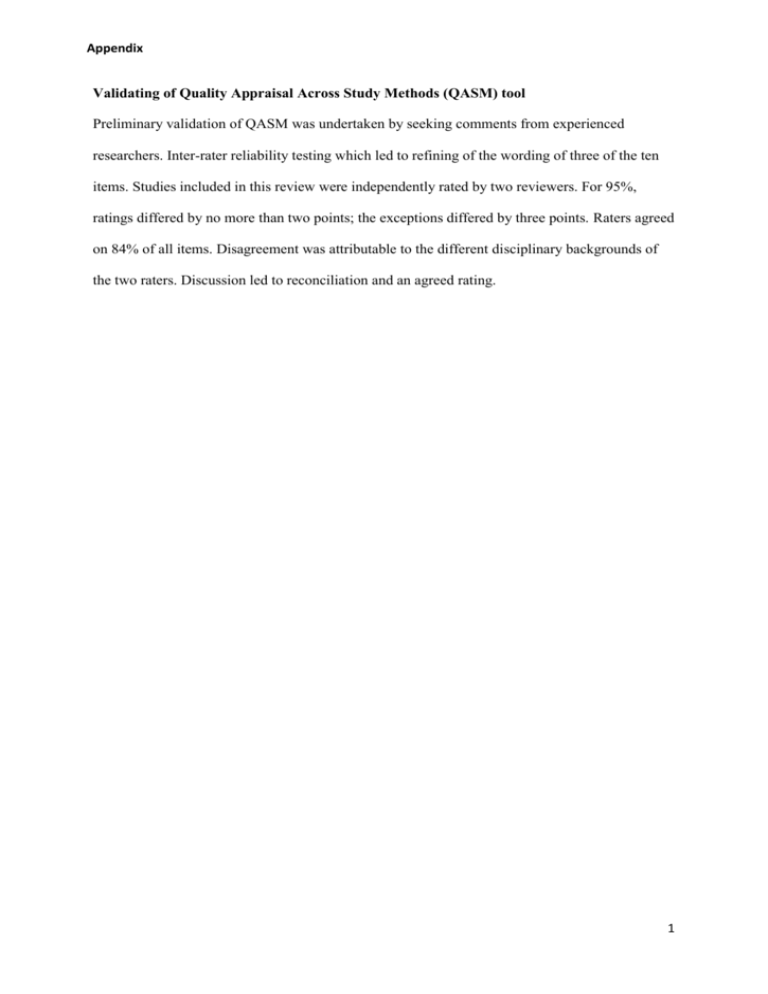Validating of Quality Appraisal Across Study Methods (QASM) tool
advertisement

Appendix Validating of Quality Appraisal Across Study Methods (QASM) tool Preliminary validation of QASM was undertaken by seeking comments from experienced researchers. Inter-rater reliability testing which led to refining of the wording of three of the ten items. Studies included in this review were independently rated by two reviewers. For 95%, ratings differed by no more than two points; the exceptions differed by three points. Raters agreed on 84% of all items. Disagreement was attributable to the different disciplinary backgrounds of the two raters. Discussion led to reconciliation and an agreed rating. 1 Appendix Figure 1 Quality appraisal across study methods (QASM) Yes No Not able to determine 1pt 0pt 0pt 0-4 pts weak*; 5-7 pts moderate**; 8-10 pts strong*** Qualitative1 Method specific Reliability of findings Validity of method and analysis Validity of method and analysis (continued) Appropriate study design Reporting 1. Stated a qualitative objective or question Quantitative descriptive2 Quantitative comparative3 Mixed Methods4 2. Gave description of demographic characteristics of interviewed participants, unless it would compromise anonymity 1. Stated a quantitative objective or hypothesis 2. Gave description of demographic characteristics of participants completing questionnaires/ surveys 1. Stated a quantitative objective or hypothesis 2. Gave description of demographic characteristics of participants completing questionnaires/ surveys 1. Stated objectives, hypotheses or research questions fitting to mixed methods research 2. Gave description of demographic characteristics of participants unless it would compromise anonymity 3. Gave clear description of qualitative methods 3. Gave clear description of quantitative methods 3. Gave clear description of quantitative methods 3. Gave clear description of mixed methods 4. Used appropriate sampling for stated qualitative objective or question 4. Used appropriate sampling for stated quantitative objective or hypothesis 4. Used appropriate sampling for stated quantitative objective or hypothesis 4. Used appropriate sampling for stated mixed methods objective, question or hypothesis 5. Qualitative methods were appropriate for 5. Quantitative methods were appropriate stated objective or question for stated objective or hypothesis 5. Quantitative methods were appropriate for 5. Mixed methods were appropriate for stated objective, stated objective or hypothesis question or hypothesis 6. Justified the qualitative data collection 6. Used appropriate outcome measures 6. Used appropriate outcome measures (e.g. 6. Justified qualitative data collection approach and (e.g. including appropriate framework used (e.g. validated measures or measures with validated measures or measures with face used appropriate quantitative outcome measures to structure questions or prompts) or face validity) validity) generation (e.g. of ethnographic data) 7. Addressed researcher’s reflexivity, 7. Addressed bias (e.g. by including 7. Addressed bias (e.g. by concealing 7. Addressed bias relative to research design critically examining the research process discussion of sample representativeness) allocation and blinding if appropriate) appropriate to qualitative and quantitative methods (e.g. discussed how factors within the that were used research process might have shaped its outcome) 8. Used analytic strategies that represented 8. Reported controlling of confounding 8. Reported comparability of study groups, 8. Considered qualitative themes from a minority of and explored both minority and majority variables and where not comparable, controlled for participants alongside dominant themes as well as views (e.g. probing minority views or the confounding variables quantitative variables that could lead to alternative ‘dissenting voice’) explanations of the data 9. Used appropriate method to examine the 9. Used appropriate method to examine 9. Used appropriate method to examine the reliability of findings extracted from the reliability of findings, using data reliability of findings, using data collected interview/ethnographic data (e.g. checking collected by questionnaire/survey (e.g. by questionnaire/survey (e.g. used two reliability of thematic coding by examined the same research question with sets of experiments to test the same independent assessment of transcripts) two different sets of data; including ‘open’ research question) survey questions) 10. Gives clear description of context in 10. Achieved complete or near complete 10. Achieved complete or near complete which qualitative data is being generated outcome data and non responses. If not, outcome data and non responses. If not, described characteristics of nondescribed characteristics of nonrespondents or drop outs respondents or drop outs 9. Used triangulation of qualitative interview/ethnographic data and quantitative questionnaire/survey data to discuss reliability of findings 10. Integrated qualitative or quantitative methods or results 1) data generated by interview/ethnographic methods; 2) data generated by quantitative methods; no comparative experimental group; 3) data generated by quantitative methods; with comparative group; 4) data generated by quantitative questionnaire/survey methods & qualitative interview/ethnographic methods 2






